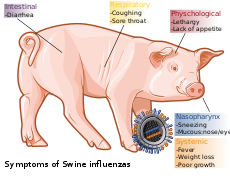As winter takes hold in Gujarat, the state is grappling with a surge in swine flu cases. In October alone, 41 cases were reported, bringing the total number of swine flu cases to 170, with 2 recorded fatalities. Notably, there were 11 cases reported in September. The escalating numbers underscore the urgency of addressing the swine flu crisis, prompting health authorities to intensify efforts to curb the spread of the virus.
 Swine flu, formally known as H1N1 influenza, earned its name because the virus that causes it has genes that are similar to those found in the influenza viruses of pigs. The H1N1 influenza A virus is a subtype of the influenza A virus, and it contains genetic material from both human and pig influenza viruses, as well as avian influenza viruses. This combination of genetic material from different sources is what gives it the name “swine flu.”
Swine flu, formally known as H1N1 influenza, earned its name because the virus that causes it has genes that are similar to those found in the influenza viruses of pigs. The H1N1 influenza A virus is a subtype of the influenza A virus, and it contains genetic material from both human and pig influenza viruses, as well as avian influenza viruses. This combination of genetic material from different sources is what gives it the name “swine flu.”
History and Origin:
- First Outbreak (2009): The most well-known outbreak of H1N1 influenza occurred in 2009. It was initially identified in Mexico and the United States, and it rapidly spread to become a global pandemic. The World Health Organization (WHO) declared it a Public Health Emergency of International Concern.
- Origin: The exact origin of the H1N1 virus is not entirely clear. It is believed to have originated in pigs, where the virus underwent genetic reassortment, leading to a strain that could infect humans. Pigs are considered intermediate hosts, as they can be infected by both human and avian influenza viruses. The virus then spreads from person to person.
- Pandemic: The 2009 H1N1 outbreak was notable for its relatively mild symptoms in most cases, but it spread easily, affecting a large number of people worldwide. The pandemic prompted widespread vaccination campaigns and public health measures to control its spread.
- Subsequent Years: After the 2009 pandemic, H1N1 continued to circulate as a seasonal flu virus. It is now one of the strains included in the annual influenza vaccine.
Importance of Monitoring:
 Swine flu remains a concern because influenza viruses have the ability to undergo genetic changes, leading to the emergence of new strains. Regular monitoring and research are essential to understand the dynamics of the virus and to develop effective vaccines to protect against emerging strains.
Swine flu remains a concern because influenza viruses have the ability to undergo genetic changes, leading to the emergence of new strains. Regular monitoring and research are essential to understand the dynamics of the virus and to develop effective vaccines to protect against emerging strains.
Public health organizations worldwide, including the WHO and the Centers for Disease Control and Prevention (CDC), continue to monitor influenza viruses, including H1N1, to ensure a timely response to any changes in the virus that may pose a threat to human health. Vaccination efforts and public awareness campaigns play crucial roles in preventing and controlling the spread of swine flu and other influenza viruses.

























